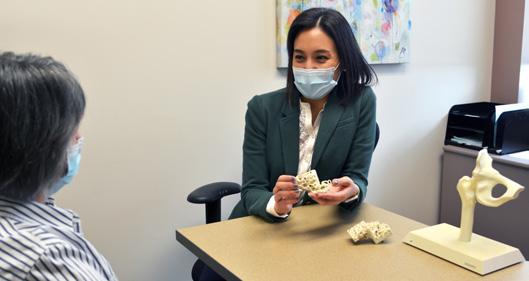
4 minute read
A LUCKY BREAK
— LEDA JARRETT, PATIENT, ST. JOSEPH'S OSTEOPOROSIS AND BONE DISEASE PROGRAM
Thanks to a fracture prevention program at St. Joseph’s Hospital, Leda Jarrett learned her broken wrist was more than a just a break – it was osteoporosis. She is now being treated for the bone-weakening disease to help ensure her first break is also her last.
Patients like Leda Jarrett are being assessed for osteoporosis when they come to St. Joseph’s Health Care London with a fracture that raises a red flag for the bone-weakening disease.
It was Leda Jarrett’s first ever broken bone and it has meant more than a year of recovery. Yet the 69-year-old is “happy as a clam” with what has happened since her fall. After an emergency room visit where the wrist fracture was diagnosed and treated, Leda was referred to the Roth|McFarlane Hand and Upper Limb Centre (HULC) at St. Joseph’s Hospital for an appointment a week later. While registering, a clinician came to talk to her about her medical history and osteoporosis. Within minutes, she was undergoing a bone mineral density test, with the results ready for review at her HULC appointment. “It was a whirlwind but I was totally amazed,” says Leda. “Nothing but good has come of the break.”
The “good” Leda refers to is learning the break was due to osteoporosis and being fast tracked to St. Joseph’s Osteoporosis and Bone Disease Program, where care is focused on prevention.


Osteoporosis is called the “silent thief” because it quietly, slowly weakens bones and often goes undetected, even after a break occurs, explains endocrinologist Dr. Kristin Clemens, Medical Director of the Osteoporosis and Bone Disease Program. Fractures caused by this bonedeteriorating condition are more common than heart attack, stroke and breast cancer combined. The fallout can be debilitating, even deadly. Yet many patients with the type of breaks that are a red flag for osteoporosis – like the fractured wrist Leda experienced – don’t get checked for the disease, adds Dr. Clemens. At St. Joseph’s, a partnership between orthopedic specialists, endocrinologists and Osteoporosis Canada is spotting those red flags and providing patients with the proper care and follow-up they need to prevent further fractures. The Fracture Liaison Service (FLS) – a fracture prevention program developed by Osteoporosis Canada – means that patients aged 50 years and older who come to HULC with a “fragility” fracture are identified, assessed for their risk of osteoporosis, and sent for imaging and follow up with the Osteoporosis and Bone Disease Program. A fragility fracture is any fall from a standing height or less that results in a fracture, says Dr. Clemens. For individuals over age 50, these fractures, which usually happen in the hip, spine, wrist or shoulder, are a warning sign that osteoporosis may be present.
...continued

Of the 76 patients in St. Joseph’s FLS database, 52 have six-month follow-up data available. Of these 52 patients, 35 were newly prescribed an osteoporosis medication during their clinic visit, with 86 per cent continuing to receive osteoporosis treatment, says Dr. Clemens.
Leda had a history of low bone density and, years ago, received infusions of a drug to treat the condition. For the past five years, however, she thought she was fine – until she fell in her garden and broke her wrist. Now, through diet, exercise, treatment, education and ongoing monitoring, she’s hoping her first broken bone was also her last. “I feel like I’m in good hands,” says Leda of St. Joseph’s comprehensive osteoporosis program. “I feel like I won’t get lost in the dust.”
50
YEARS OF AGE AND OLDER
is the most common age range affected by osteoporosis. However, it can affect people at almost any age.
2 MILLION CANADIANS
are affected by osteoporosis.
PEOPLE LIVING WITH OSTEOPOROSIS
face a reduced quality of life, lowered self-esteem, reduction or loss of mobility, disfigurement, a lack of independence and in some cases, death – 28 per cent of women and 37 per cent of men who suffer a hip fracture will die within the following year.
80%
of fragility fractures occur in menopausal women over the age of 50.
FRACTURES FROM OSTEOPOROSIS
are more common than heart attack, stroke and breast cancer combined.
1 IN 3 WOMEN & 1 IN 5 MEN
minimum will break a bone due to osteoporosis in their lifetime.

Education is a key component of the Osteoporosis and Bone Disease Program at St. Joseph’s Hospital, where endocrinologist Dr. Kristin Clemens is leading a fracture prevention program for individuals over age 50 who come to the hospital with a break that raises a red flag osteoporosis. The goal is to catch and treat osteoporosis early and prevent further fractures.









